|
|
Post by elosha11 on Aug 16, 2016 18:30:54 GMT 5
This is a whale's caudal vertebrae. The large holes are naturally occurring; they are canals for the spinal arteries. But the slice marks are the mark of a large shark, probably Megalodon. 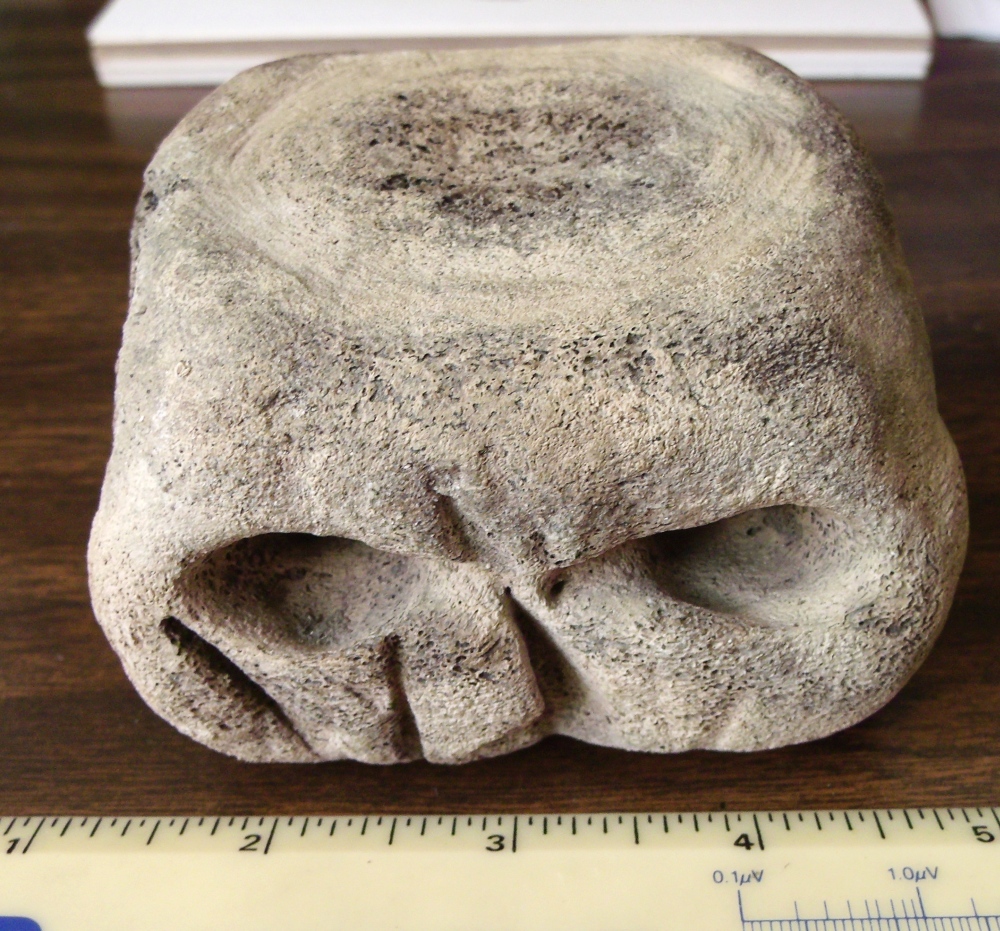 |
|
|
|
Post by elosha11 on Aug 17, 2016 20:16:02 GMT 5
|
|
|
|
Post by elosha11 on Aug 19, 2016 16:47:45 GMT 5
This is a really cool one. Here's another example of a whale vertebral centra apparently bitten in half by a Megalodon. The centra is about 6 inches in diameter. This one was found in the PCS Mine in Aurora, North CArolina. Here's the pic and description. The website is www.fossilguy.com/species/vert/mammal/l_crk/pred_vert1.jpg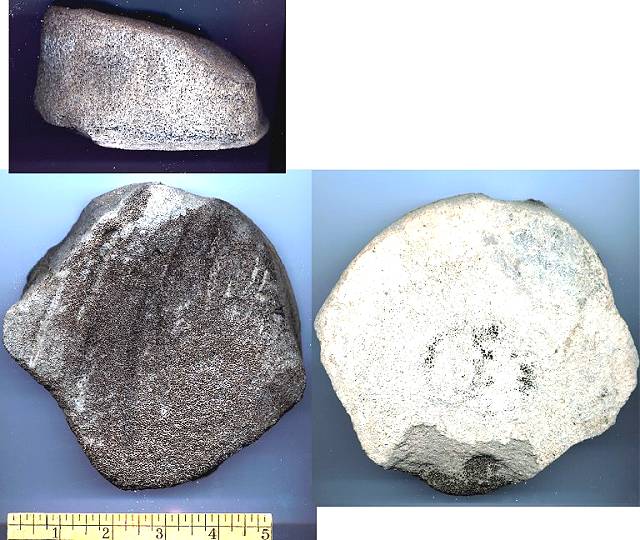 This whale vertebra was apparently bitten in half. If one looks at the inside half of the vertebra (the lower left image), one can see a series of 2-4" long, and 1/8" deep scrape marks running almost vertically down the vertebra. These scrapes were probably caused by the teeth slicing the vertebra in half. Such large scrape marks makes me beleive this was done by a megalodon. Formation: Yorktown Age: ~ 2.5-5 m.y. Location: PCS Mine, Aurora, NC |
|
|
|
Post by elosha11 on Sept 5, 2016 20:33:06 GMT 5
A number of my first postings in this thread now lead to dead links. I'm trying to restore as many of them as I can, including the bitten whale vertebrae I reposted from the web archive, the wayback machine earlier in this thread. Here's the re-posting of the presumed baleen whale rib with bite legions suggesting a 4 to 8 meter shark attacker. I know there's been some question in the past as to how the researchers could suggest this was a baleen whale from merely a rib fragment. Here's the explanation from NG website. I will post links to several articles, including NG. "Calvert Marine Museum paleontologist Robert Kallal and his coauthors described the specimen in a 2012 International Journal of Osteoarchaeology study. Even though the rib fragment wasn’t found in place, the researchers pointed out that the identity of the fossil as part of a baleen whale narrows down the age of the specimen. At the locality where the shard was picked up, baleen whale remains are only found in the 3-4 million year old Pliocene rock of the Yorktown Formation. From the anatomy of the bone and the site’s fossil roster, the best candidate for the owner of the rib might be an ancient humpback whale."  phenomena.nationalgeographic.com/2013/08/06/healed-bone-gives-away-prehistoric-shark-bite/insider.si.edu/2011/11/details-of-ancient-shark-attack-preserved-in-fossil-whale-bone/phys.org/news/2011-11-ancient-shark-fossil-whale-bone.html phenomena.nationalgeographic.com/2013/08/06/healed-bone-gives-away-prehistoric-shark-bite/insider.si.edu/2011/11/details-of-ancient-shark-attack-preserved-in-fossil-whale-bone/phys.org/news/2011-11-ancient-shark-fossil-whale-bone.html |
|
|
|
Post by elosha11 on Sept 5, 2016 20:43:04 GMT 5
Does anyone else find it a bit odd that we have no known evidence of prehistoric ceteacean feeding on other cetaceans? We now know that Livyatan (or closely associated species) apparently were much more widespread than just Peru and a longer living species than previously speculated. A similar sized tooth was found on an Australia beach, and it was also much younger than the Livyatan holotype. So why do we not see some clear indication of Livyatan feeding on whale bones or other smaller sperm whale feeding? Obviously such marks would look somewhat different than a shark's feeding and perhaps would be more blunt impact or evidence of crushing. Perhaps it's harder to find such evidence in the fossil record, than shark scratched, cut, or crushed bones.
Could it be that these animals were pickier eaters than sharks and thus did not scrape down on bones nearly as often. We see that orcas often do not eat their cetacean prey right down to bone, where they could possibly leave scrape marks or break the bones. Instead, the orcas choose more delicate parts to eat, such the tongue and blubber. I wouldn't think such a large animal as Livytan could afford to be so picky, given its huge caloric demands, but who knows? Maybe prey was so plentiful in the Miocene that it could afford to be that picky.
|
|
|
|
Post by creature386 on Sept 5, 2016 21:11:16 GMT 5
I think the explanation for this could be the same as for the poorer fossil record of Livyatan. It was possibly simply not as numerous as Megalodon.
|
|
|
|
Post by elosha11 on Sept 5, 2016 22:30:47 GMT 5
^Cetaceans generally are relatively fast breeding for such large animals, and absent human pressures, usually have a thriving ocean population. For instance orcas and sperm whales were very numerous prior to human hunting. Whales also show a strong ability to bounce back after overhunting. Given what should have been an ample prey base and obviously no human interaction, I can't understand why Livyatan would have a very small population. I would think there very well may have been at least a few hundred thousand in the ocean at any one time during the Miocene. It now seems they may have been a more widespread and longer-lived species which also indicates a good-sized population.
|
|
|
|
Post by theropod on Sept 6, 2016 0:59:36 GMT 5
Being a picky eater isn’t a viable explanation imo. How would an animal with the jaw size of Livyatan be able to consume its cetothere-sized prey without affecting the bones in the process?
Orcas indeed are picky eaters, but that’s only on whales vastly larger than themselves, there’s really no comparison.
Once we get to that point it becomes more likely that it simply digested the bones rather than leave them with no trace of feeding whatsoever. But that would be a behaviour I’ve never heard cetaceans to engage in (on large animals that is, obviously they eat small fish whole).
But a possibly more parsimonious alternative:
Livyatan and raptorial physeteroids may have been more widespread and long-lived than we used to give them credit for, but that doesn’t mean they must have been particularly numerous.
I think it’s fallacious to assume that Livyatan automatically must have had a large population just because some extant whales did before they were hunted. Populations of some animals are naturally small, and even with a small population worldwide occurrences could be explained by migratory behaviour.
More to the point, I think that irrespective of what their respective population sizes may have been, the evidence is very clear that C. megalodon is more common in the fossil record, and not just based on counting teeth; the palaeobiology database lists 182 occurrences of "physeteroidea" and 240 of "Carcharocles megalodon" prior to the quarternary. Now keeping in mind that these physeteroids include various piscivorous and teuthivorous forms and that probably only a fraction include macrophagous taxa, it’s quite obvious that raptorial stem-physeteroids aren’t anywhere near as common in the fossil record as C. megalodon. So one way or another, couldn’t whatever is making the physeteroids’ fossils so rare also be preventing us from finding any bite marks?
In the specific case of Livyatan, even if we assume the Pliocene tooth from Australia pertains to this taxon, that brings our number of individuals up to two. Yes, two that span quite an impressive timespan, but it’s still a ludicrously low number, so if it’s weird that there are no bite marks, then it’s equally weird that there are just two fossil specimens. We generally don’t have any bite marks from predators that are only known from two individuals, generally it such low numbers indicate a lack of sampling that probably also affects whatever they may have bitten into.
A difference in habitat, for instance would provide an explanation for both problems. If raptorial physeteroids tended to inhabit, and hunt in, pelagic settings, places that have not since been exposed on land, then there’s no wonder we’d have difficulty finding remains of their meals which would still be lying somewhere in the middle of an ocean.
However keep in mind that bite marks can sometimes be very indistinct, and I wouldn’t dismiss the possibility that the occasional physeteroid bite mark may have been found, but misidentified as a shark bite mark due to sharks being a lot more common and well-known.
|
|
|
|
Post by coherentsheaf on Sept 6, 2016 2:56:11 GMT 5
Teuthophagy?
|
|
|
|
Post by neogeneseamonster on Sept 6, 2016 10:43:41 GMT 5
To compare the number of bite marks left by Livyatan and megalodon, we have to classify ontogenetic stage of possible attacker (in this case, megalodon). I know it is ridiculously hard to estimate size of a shark just by looking at bite mark, but it is possible that majority of bite marks may have been made by younger individuals. If this assumption is true, the question why we see lots of megalodon bite marks on whale bones is the same question as why we see lots of young megalodon teeth: because younger sharks are more common and inhabits shallow, coastal water. Of course, I'm not suggesting that most of the bite marks were made by young sharks since I have no scientific data to assert such claim. However, I think we need to answer this question first: how many of meg bite marks are made by relatively large, adult megalodon. Since sharks have quite different population structure to that of whales (much higher proportion of juvenile due to lack of parental care, unlike cetacean), such factor may be important when comparing livy and meg.
Ps. I will try to find more specific data regarding population structures (based on age or ontogenetic stages) of sharks and cetaceans.
|
|
|
|
Post by elosha11 on Nov 14, 2016 1:24:09 GMT 5
|
|
|
|
Post by elosha11 on Dec 29, 2016 19:36:46 GMT 5
Newly discovered rorqual ancestor, Incakujira anillodefuego, found in Peru. Adult size estimated at 8 meters. The below image is of one of only two or three discovered specimens. This one had many teeth of the extinct mako shark/great white ancestor associated with it. Image taken from coastalpaleo.blogspot.com/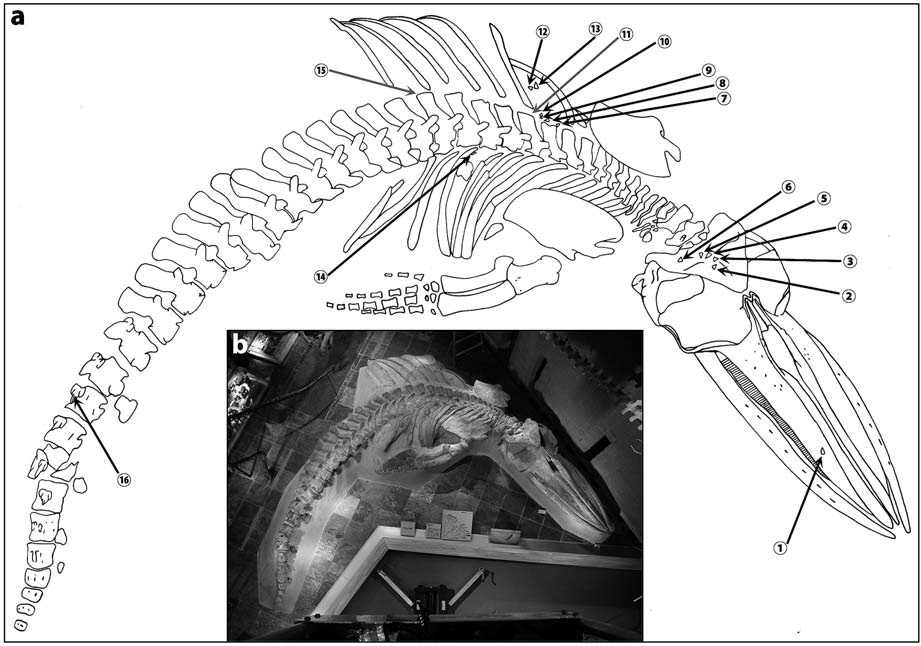 Carcharodon hastalis teeth found in association with a skeleton of the Miocene baleen whale Incakujira from Peru (Yuji, 2014).
EDIT: Here's the link to the Japanese research paper, with an English abstract. From the varying size of the teeth, it appears at least two Isurus hastalis makos fed on the whale, one of the sharks may have been smaller than the other.www.academia.edu/8527744/A_dense_occurrence_of_teeth_of_fossil_mako_shark_Isurus_hastalis_Chondrichthyes_Lamniformes_associated_with_a_balaenopterid-whale_skeleton_of_the_Late_Miocene_Pisco_Formation_Peru_South_America_Japanese_with_English_abstract_The author also posted these interesting observations between shark teeth and cetacean bones:
I found this shark tooth near this whale bone – the shark must have eaten it!”This is a very common misconception. Whale bones are often found with shark tooth bite marks – a skeleton recently donated to us has bite marks on more than 30% of the skelton, and relative to the paltry number of such traces I recorded in the Purisima Formation assemblage, the number of shark-bitten bones on the east coast is staggering. Such traces are god evidence of fossil behavior – and different traces reflecting different types of teeth have been named as trace fossils (ichnofossils). However, the case is more difficult to make when there are no such traces. Slow deposition can result in a slightly higher than normal concentration of teeth in addition to marine mammal bones. Association of bones and teeth – especially if the “skeleton” consists of just a couple of bones or a single bone – are commonly formed by sedimentary reworking and concentration. If any sign of transport or reworking is obvious – abrasion, polish, fragmentation – then the fossil association is almost certainly caused by reworking. If the fossils were found in a bonebed, then it's not possible to infer any behavior. The following conditions must be met to infer predation-based association of shark teeth and a prey item in the marine vertebrate fossil record: 1) there must be evidence that the prey animal (marine mammal in our case) represents a single individual and is isolated in the sediment; 2) there must not be any evidence that the associated teeth are from a condensed section, during which vertical differences may not indicate closeness in time; 3) the shark teeth must be found near the skeleton and in a higher concentration than surrounding sediment. Classic bulletproof examples include articulated marine mammals and marine reptiles preserved in fine-grained deposits with dozens to hundreds of shark teeth clustered in a halo around the skeleton. In extremely rare cases shark teeth may even be embedded into bone - clear evidence of predation activity. |
|
|
|
Post by elosha11 on Feb 10, 2017 3:30:39 GMT 5
|
|
|
|
Post by elosha11 on Feb 13, 2017 2:18:10 GMT 5
|
|
|
|
Post by elosha11 on Feb 13, 2017 2:55:50 GMT 5
Another whale humerus bone. 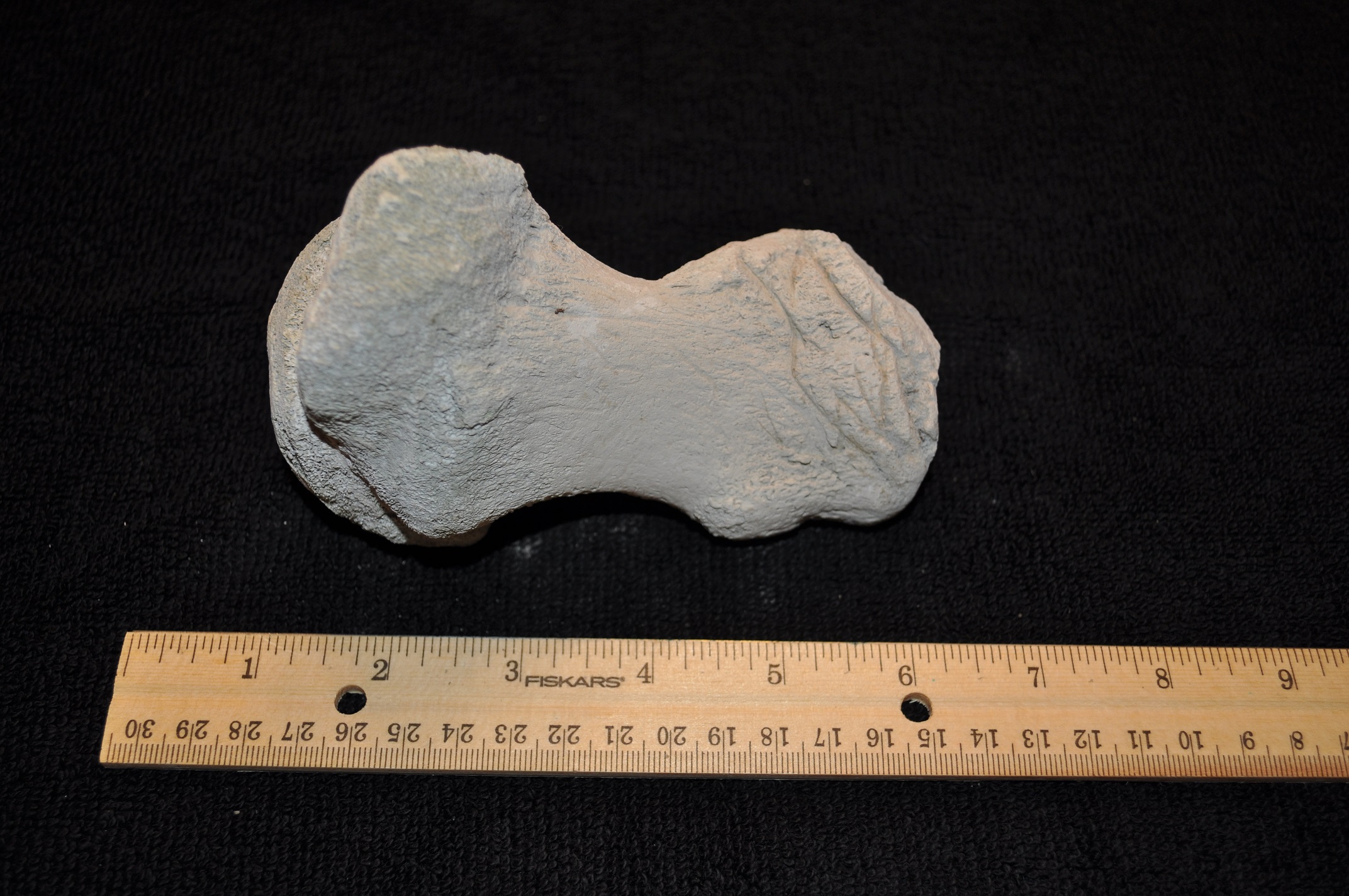 Another fairly large cetacean vertebrae with significant bite damage 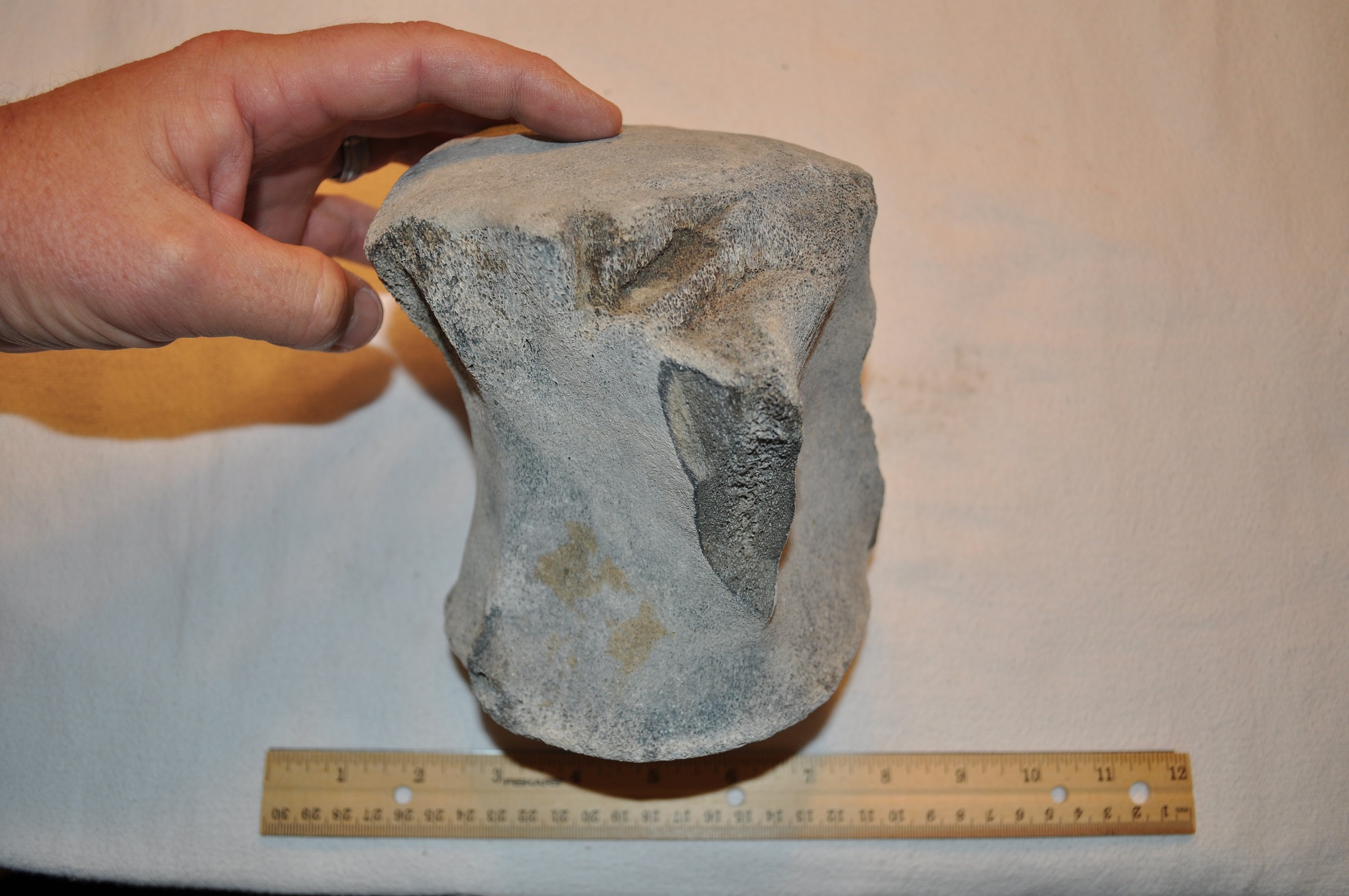 |
|